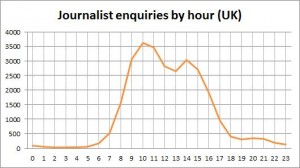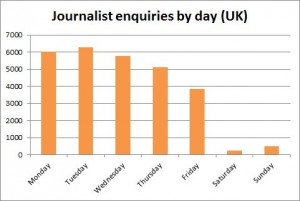When do journalists send requests?
We took a look at the ResponseSource Journalist Enquiry Service data to see if there is a significant pattern to when journalist requests are sent. We wanted to know if there was a specific time of day or day of the week to look out for media enquiries.
The answer is 10am on Tuesday morning.
That’s a bit of a simplification, but in terms of time of day, enquiries begin to pick up at around 7am and there is a gradual build up during the day to a significant peak between 9am and midday. Then they slump a little over lunch followed by a less sustained peak at 2pm, after which enquiries gradually drop off to a plateau between 7pm and 9pm, then flattening out until the next morning.
Looking at days of the week, Tuesday (23 per cent of enquiries) is the most popular for sending journalist requests followed closely by Monday (22 per cent) then Wednesday (21 per cent). Volumes drop a little more on Thursday (18 per cent) and Friday (14 per cent) is clearly the least busy working day. On the weekend, journalist requests are more likely to come through on a Sunday (2 per cent) than a Saturday (1 per cent).
Journalists clearly work odd hours sometimes. We found 15 per cent of enquiries come in outside normal business hours of 9am to 6pm. In 2015 a total of 30 enquiries came in between 3am and 4am and during the year there were 761 requests over the weekend.
So, what does all this mean for a PR professional? Well, depending on how you work it could suggest times that might be better for monitoring and responding to ResponseSource requests. Feedback from clients suggests that the sooner you respond to a journalist request the more likely that your input will be used. So if you’re in charge of a team, making sure you have people monitoring at the busiest times may help with results. Or if you have a small team and are only able to dip in and out of responding to enquiries, you could choose to do this on a Tuesday morning or if you have an hour a day then 10-11am each day, in order to increase your chances of responding quickly to a relevant enquiry.
We analysed data for calendar year 2015, a total of 27,779 journalist requests – the graphs above show the total numbers of enquiries over the year by day or hour. A quick look at 2016 data showed a consistent pattern so far.

